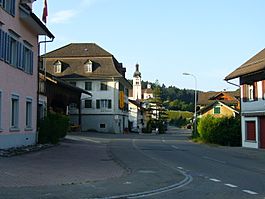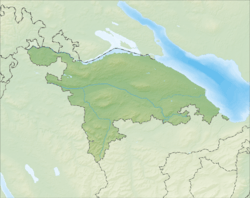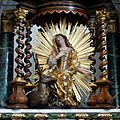Fischingen facts for kids
Quick facts for kids
Fischingen
|
||
|---|---|---|

Fischingen village
|
||
|
||
| Country | Switzerland | |
| Canton | Thurgau | |
| District | Münchwilen | |
| Area | ||
| • Total | 30.58 km2 (11.81 sq mi) | |
| Elevation | 625 m (2,051 ft) | |
| Population
(Dec 2020 )
|
||
| • Total | 2,836 | |
| • Density | 92.740/km2 (240.20/sq mi) | |
| Postal code |
8376
|
|
| Surrounded by | Bichelsee-Balterswil, Eschlikon, Fischenthal (ZH), Kirchberg (SG), Mosnang (SG), Sirnach, Sternenberg (ZH), Turbenthal (ZH), Wila (ZH) | |
Fischingen is a small town, also called a municipality, located in the Thurgau area of Switzerland. It's part of the Münchwilen district.
Contents
History of Fischingen
Fischingen was first written about in the year 1328. In 1972, several nearby villages like Dussnang, Oberwangen, and Tannegg joined with Fischingen.
The village grew north of the Benedictine Fischingen Abbey, a type of monastery, which was built in the 1100s. Fischingen was part of an old court system that started in 1432. It was closely linked to the Tannegg Amt, which was a local administrative area. This Amt bought the Abbey in 1693.
The Catholic church in the village was supported by the Abbey. However, the Reformed people living there belonged to a different church in Dussnang. In 1848, the Abbey closed, and its church became the main church for a new, separate parish.
Fischingen was on the path to Einsiedeln, a place famous for its pilgrimage church. Because of this, many pilgrims visited Fischingen in the 1500s and 1600s. A special chapel for pilgrims grew up around the grave of Saint Ida, who had lived at the Abbey. In the 1600s and 1700s, the Abbey buildings were rebuilt in fancy Baroque and Rococo styles. A new Abbey church was built between 1685 and 1687. In 1705, a new chapel for Saint Ida was also built.
Geography and Landscape
Fischingen covers an area of about 30.62 square kilometers (11.82 square miles). A large part of this land, about 47.6%, is used for farming. Forests cover another big portion, about 46.2% of the area.
About 5.8% of the land has buildings or roads. A very small part, 0.2%, is made up of rivers or lakes. The rest, about 0.3%, is land that cannot be used for farming or building.
The town is located in the Münchwilen district, at the northern base of a mountain called the Hörnli. Fischingen includes the main villages of Fischingen, Au, Dussnang, Oberwangen, and Tannegg. It also has over 100 smaller, scattered settlements.
Population and People
Fischingen has a population of about 2,569 people. Most people in Fischingen speak German, which is about 96.2% of the population. Other languages spoken include Albanian and Serbo-Croatian.
In 2008, about 51% of the population were male and 49% were female. Most people living in Fischingen are Swiss citizens.
The age groups in Fischingen in 2009 were:
- Children (0-9 years old): 10.0%
- Teenagers (10-19 years old): 14.1%
- Young adults (20-29 years old): 11.2%
- Adults (30-59 years old): 44.1%
- Seniors (60 years and older): 20.7%
Most households in Fischingen are private homes, with an average of 2.7 people living in each. Many people live in single-family homes.
The population of Fischingen has changed over time:
| year | population |
|---|---|
| 1850 | 2,125 |
| 1900 | 2,570 |
| 1950 | 2,484 |
| 1970 | 2,248 |
| 1980 | 2,100 |
| 2000 | 2,605 |
Important Heritage Sites
Several places in Fischingen are considered important heritage sites in Switzerland. These include:
- St. Martins Chapel
- The Catholic Church of Dussnang
- The Benedictine Monastery (which is now a Priory) with its Church and Ida Chapel
- The old ruins of Tannegg Castle
The entire Fischingen Monastery area is also part of the Inventory of Swiss Heritage Sites, which means it's a special place to protect.
Economy and Work
In Fischingen, people work in different types of jobs.
- The primary sector involves jobs like farming and forestry.
- The secondary sector includes jobs in manufacturing and construction.
- The tertiary sector covers jobs in services, like shops, healthcare, and education.
Many people who live in Fischingen also travel to other towns for work. A good number of people also come into Fischingen to work. Most people use a private car to get to work, while some use public transportation.
Religion in Fischingen
According to a census in 2000, the main religions in Fischingen are:
- Roman Catholic: 53.9% of the population
- Swiss Reformed Church: 31.3% of the population
There are also smaller groups of people who belong to other Christian churches, the Orthodox Church, and Islam. Some people do not belong to any church or did not answer the question about their religion.
Education in Fischingen
In Switzerland, most people are well-educated. In Fischingen, about 73.5% of adults (aged 25–64) have finished either high school or gone on to higher education, like university.
Fischingen has its own primary and secondary school district. In the 2008/2009 school year, there were 298 students in total.
- There were 59 children in kindergarten.
- There were 94 children in the lower primary school (ages 5-6).
- There were 102 children in the upper primary school.
- At the secondary level (starting around age 12), students are grouped by how well they learn. There were 59 teenagers in the advanced school and 43 in the standard school.
Images for kids
See also
 In Spanish: Fischingen para niños
In Spanish: Fischingen para niños











